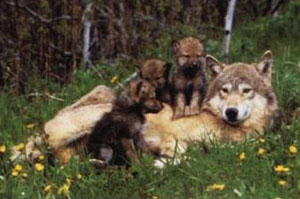
Since the ruling, over 1000 wolves have been murdered - there are only 300 left in Montana and Idaho.
05/10/2013
SustainableBusiness.com News
Although this story isn't about business, we want you to know about it.
With just a stroke of a pen, Congress gave Idaho, Montana and then later, Wyoming, what they wanted - state control of wolves. And last year, wolves were removed from Endangered Species status in the Great Lake States. Until now, taking a species off the Endangered list has been based on scientific data that shows a population has recovered.
After more than a decade of effort and millions of dollars, wolf populations are back from the brink of extinction in the US, but still occupy only 5% of their original range. There were only 350 wolves in Wyoming, 1500 in Montana and Idaho and about 4000 in Wisconsin, Minnesota and Michigan.
States are required to maintain a population of at least 150 wolves, including 15 breeding pairs, to prevent being put back on the Endangered Species List.
In Wyoming, for example, wolves tend to be found in or near Yellowstone and other parks and refuges - they can't be killed inside a park, but if the happen to wander they are game from October through December. Elsewhere in the state they are classified as "predatory" animals, which removes all regulations on when and how they can be killed.
In all the states, wolves are killed in heinous ways. They can be pursued by a mechanized vehicle, poisoned, dens gassed, trapped and lured by leaving a dead wolf. And hunters can go after wolves in breeding season, and kill pregnant mothers and pups.
Why do people hate wolves so much?
It is livestock owners and hunters that want wolves gone. Defenders of Wildlife and other groups have long compensated ranchers for any cow or sheep killed by a wolf, along with working with them to make their animals less attractive to wolves. Hunters are always in favor of removing predator populations because they allows their favorite targets to flourish and overpopulate.
Gray wolves are responsible for 3.7% of lost cattle in the US, less than dogs, which are at 9.9%, according to the US Department of Agriculture.
Wolves are a keystone species. As the top of the pyramid, re-introduction of wolves in Yellowstone National Park, for example, has revived the ecosystem. "The data show a clear and remarkable linkage between the presence of wolves and the health of an entire streamside ecosystem, including two species of cottonwoods (that were close to extinction) and the myriad of roles they play in erosion control, stream health, and nurturing diverse plant and animal life," says Science Daily.
In the past two weeks, anti-wolf lobbyists secured 72 Congressional signatures for a letter to the U.S. Fish and Wildlife Service demanding that wolves in the Lower 48 be completely delisted from the Endangered Species Act.
The U.S. Fish and Wildlife Service is moving forward on this, which would be catastrophic for gray wolves across America. It would also set a dangerous precedent that Congress can force species to be prematurely delisted before they have recovered.
When the Endangered Species Act was introduced in 1973, there were almost no gray wolves left in the continental US - today there are about 6,000. Another 8,000-11,000 are in Alaska, where they are not protected and have long been hunted using aircraft. Wolves were once one of the most common animals in the US, until unregulated hunting brought them close to extinction.
There are many areas for wolf populations to expand, if they were only allowed to do so.
source

No comments:
Post a Comment